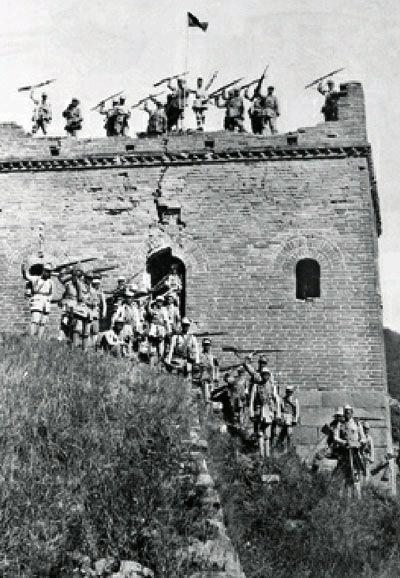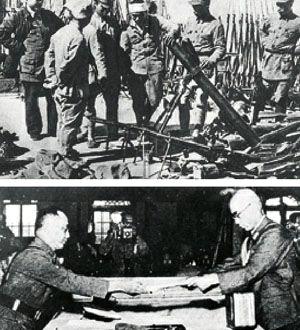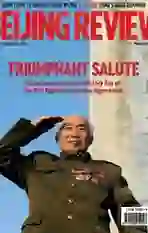BETWEEN WAR AND PEACE
2014-09-23ByYinPumin
By+Yin+Pumin
Sixty-nine years ago, on August 15, 1945, Japan unconditionally surrendered to the Allies, marking the end of Chinas War Against Japanese Aggression and World War II (WWII).
With the war ended and peace resumed in Asia, billions of people had the chance to breathe a sigh of relief, recover and rebuild their lives. This included about 70 million Japanese.
In memory of the hardship suffered and struggle waged by the Chinese people in this war, the Standing Committee of Chinas National Peoples Congress in February this year designated September 3 as the Victory Day of the War of Resistance Against Japanese Aggression, and December 13 as the National Memorial Day to commemorate over 300,000 Chinese killed by Japanese aggressors during the 1937 Nanjing Massacre.
The war years
The 69th anniversary presents one with the opportunity to remember a proud yet harrowing period of Chinas modern history. The War Against Japanese Aggression was a resounding victory for the Chinese but one that came at a terrible cost.
Early in 1931, the Japanese aggressors began plotting to conquer Chinas northeast provinces. On September 18 that year, Japanese officers incited the Mukden Incident, leading to the total occupation of Manchuria (northeast China) in five months.
The Japanese made further plans to conquer the north of China, where they planned to build up a continental base for their countrys further territorial encroachment on the Asian continent.
Faced with a dire situation, the Communist Party of China (CPC) proposed a United Front between political parties, groups and armies against Japan.
Then came the Xian Incident in December 1936. Under the efforts of the CPC, Chiang Kai-Shek (1887-1975), then Chairman of the National Military Council of the Chinese Government, agreed to head the United Front. From thereon out, the Chinese people rallied around the Kuomintang (KMT) and the CPC to fight their common enemy.
The Japanese Army then bombarded Wanping, a county near Beijing on July 7, 1937, and started a full-scale war of aggression.
“From then on, the whole of China was engaged in an anti-invasion war, opening the first major anti-fascist battlefield in the worlds East,” said Peng Xunhou, a professor with the Academy of Military Science of the Peoples Liberation Army.
On August 13, 1937, the Japanese opened a second front in Shanghai, targeting Chinas economic capacity for war. Chiang deployed some of his best troops, which succeeded in stalling the enemys advancement for three months.endprint
Japanese tactics ultimately prevailed, causing a rapid disintegration of Chinese defenses. The enemy then swiftly advanced to the gates of the then-Chinese capital, Nanjing.
Chiang moved his capital to Chongqing, where the geographical surroundings made it all but impossible for the enemy to penetrate. This dashed Japanese hopes for a speedy resolution to the conflict.
Although the Japanese quickly captured all key Chinese ports and industrial centers, the combined KMT and CPC forces continued to resist them.
In the conflict, the Japanese forces committed many massacres and atrocities, most infamously in Nanjing in December 1937, when Japanese troops slaughtered an estimated 300,000 civilians. Warfare of this nature led, by the wars end, to an estimated 10 million to 20 million Chinese civilian deaths.
By 1940, the war had descended into a stalemate. The Japanese seemed unable to force victory, nor the Chinese to evict the Japanese troops.
“The Chinese battlefield made a great contribution to the whole anti-fascist war around the world. Without the tenacious resistance by the Chinese people, the strategic situation would have been far more favorable for the German-Italian-Japanese fascist bloc when WWII broke out full-scale in 1939,” Peng said.
Until the Pearl Harbor Incident in 1941, the Chinese fought the Japanese armies practically alone. “During this time, a poor and underdeveloped country held down some 800,000 troops from one of the most highly militarized and technologically advanced societies in the world,” said Rana Mitter, a professor of the history and politics of modern China at the University of Oxford in Britain.
In July 1938 and again from May to August in 1939, the Japanese army division in northeast China assaulted the Soviet army. In both attacks, the Japanese failed, largely because a large portion of its forces was engaged in fighting in other parts of China.
On August 20, 1940, the troops under CPC leadership launched the well-known Hundred Regiment Campaign, during which the CPC forces fought a total of 1,824 large- and smallscale battles, inflicted 20,645 casualties upon the Japanese troops, destroyed major railways and highways, rooted up 2,993 strongholds of the enemy and puppet troops, and recovered 40-50 counties.
China as battlefield
The outbreak of the Pacific War in 1941 saw the Allied powers establishing a China-Burma-India theater of war, beginning January 5, 1942.endprint
Along with Joseph Stilwell (1883-1946) as the chief of staff of the Chinese army, a group of American volunteer pilots in China, the Flying Tigers, were incorporated into the United States 14th Air Force on July 4, 1942, with Claire Chennault (1893-1958) as commander.
During the early phases of the Pacific War, the Allied performance was poor in contrast with the Chinese resistance. Hence, former U.S. President Franklin Roosevelt (1882-1945) was determined to make China one of the Big Four.
He said, “Had China not been fighting, or had China been defeated, how many Japanese troops do you think would then be deployed to other regions to fight? They would have captured Australia and India all at once, and then pushed to the Middle East.”
After the Pacific War broke out, the Chinese battlefield continued to engage most of the Japanese army, greatly boosting the strength of the United States, Britain and other countries in their war against Japan.
China inflicted heavy casualties on the Japanese, costing them 1.5 million troops, up to 70 percent of the total Japanese troops killed during WWII.
However, the Chinese people also paid dearly for this victory. Total casualties were estimated at 35 million. The direct property loss suffered by the Chinese was valued at$100 billion and the indirect property loss at$500 billion.
On November 1, 1943, the United States, Britain and the Soviet Union accepted China as one of the cosigners of the Moscow Declaration. On December 1, 1943, China, Britain and the United States jointly issued the Cairo Declaration. The Potsdam Proclamation was also jointly issued by Chinese, American and British governments on July 26, 1945, sounding the death knell for fascist warmongers worldwide.
On August 15, 1945, the war ended with the Japanese declaring unconditional surrender. The Chinese people had achieved their first antiimperialist victory since the Opium War in 1840-42. On September 2, 1945, the Instrument of Surrender was signed on board the USS Missouri in Tokyo Bay.
After eight years of epic fighting, the Chinese people witnessed the fall of the Japanese fascist regime and embraced a new epoch in which Asia took steps toward peace.
Sino-Japanese relations
The international order forged after WWII contributed to the general peace in Asia for almost seven decades, a period during which Japan has risen to be one of the most important global economies.endprint
China had decades of friendly relations with Japan after the two countries established formal diplomatic ties in 1972. However, since 2012, those ties have become strained as the Japanese Government and right-wing politicians have continued to repeatedly cross the line with China on historical issues.
The relations between the two countries started to further deteriorate after Japanese Prime Minister Shinzo Abe took office in late 2012, and they flared up when Abe visited a notorious war shrine on December 26, 2013.
The latest confrontation between China and Japan came on August 15 as Japanese Cabinet ministers paid their respects again at the Yasukuni Shrine.
Abe sent a ritual offering to the shrine, which honors 14 Class-A Japanese war criminals, and this, in addition to the visits made by ministers and lawmakers, has further ratcheted up tensions between Japan and China.
According to Zhou Yongsheng, a professor of Japanese studies at China Foreign Affairs University, huge ambitions for military expansion and even preparations for wartime operations have been placed on Japanese Prime Minister Abes agenda, and this radical policy campaign looks set to continue.
In April, Japan eased arms export rules, approving its first weapons exports in July. Japans Mainichi Shimbun newspaper said the Defense Ministry is also looking at new ways to incorporate civilians into the military in special circumstances.
“Its a dangerous signal that also appeared before the war,” said Li Wei, Director of the Institute of Japanese Studies at the Chinese Academy of Social Sciences. “Japans aggression had its roots in the society of militant Japan. When deciding to invade China, wage the Pacific War, and attack Southeast Asia, Japanese rulers said they were ‘fighting for survival and many Japanese believed such nonsense.”
“The similar hysteria in Japanese society today must be rooted out in order to win the trust of China and other Asian countries, and that requires the Japanese leadership to adopt an accurate view of history,” Li added.
When addressing the 77th anniversary of the Lugou Bridge Incident on July 7, which marks the beginning of the full-scale war, Chinese President Xi Jinping said, “History is history and facts are facts. Nobody can change either.”
“Anyone who intends to deny, distort or beautify the history of aggression will never be tolerated by Chinese people or people of other countries,” said Xi, referring to widespread concerns that Japan is trying to misrepresent the history of the war.endprint
“Xis speech again clarifies Chinas tough stance against Japans moves,” said Ling Xingguang, Director of the Tokyo-based SinoJapanese Relationship Institute.
“Its a pity that a small minority of people still ignore iron-clad history and the fact that tens of millions of innocent people lost their lives,” Xi said in his speech.
When China and Japan normalized bilateral relations in 1972, it was listed in their joint declaration that Japan should view history without bias and not deny its historical aggression against China. That commitment was considered a cornerstone for bilateral political ties and a prerequisite for improving relations.
“Where Sino-Japanese ties will head in the future will be decided by which kind of political attitude, be it the win-win or the zero-sum mentality, that Japans Abe government takes toward China,” said Liu Jiangyong, Deputy Director of the Institute of International Studies at Tsinghua University.
“It is too early to say if Japan will revive its pre-war militarism, but the disclosed strategy of the Abe Cabinet regarding China as a military rival should remind the latter of the urgent need for maintaining peace both domestically and in East Asia,” Liu said.
Some Japanese media outlets have started to call for serious improvements to diplomatic relations with China and South Korea through policy shifts, said Ling of the Tokyo-based SinoJapanese Relationship Institute.
“The latest boost in cooperation between China and South Korea marked by Xis visit to Seoul made a considerable impact on Japan. Xis unprecedented presence at the commemoration on July 7 also exerts pressure on Abe. We hope these influences will strengthen the friendly voices,” he said.
Ma Junwei, a scholar at the China Institute of Contemporary International Relations, said he believed Sino-Japanese relations will continue to grow in the long run with periodic ups and downs, and he gave the recent foreign ministers meeting on August 9 as an example of an upturn.endprint
